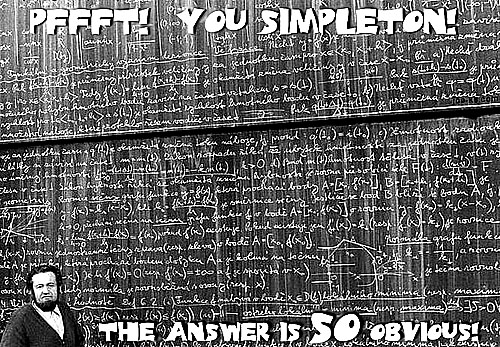Introduction
Most of these are pretty obvious, but are included for completeness. Be sure to examine the DeltaV nomogram and the Acceleration nomogram. Some of these equations are available in the Atomic Rocket Tiddly Wiki. And don't miss the list of on-line calculators.
Units and Functions
| Element | Value |
|---|---|
| e | 2.71828... |
| kg | kilograms |
| m | meters |
| N | newtons |
| π | 3.14159... |
| s | seconds |
| w | watts |
| ln[x] | natural logarithm of x |
| sqrt[x] | square root of x |
Information about the mass and radius of various planets can be found here: http://nssdc.gsfc.nasa.gov/planetary/planetfact.html

Adapted from an image courtesy of NASA
Index
A: Acceleration of spacecraft (m/s2)
A = F / Mc
A = (mDot * Ve) / Mc
A = (mDot * g0 * Isp) / Mc
Apg: Acceleration of spacecraft in terms of planetary gravities (gp)
Apg = A / gp
Δv: Spacecraft's total change in velocity capability (deltaV) (m/s)
ΔV = Ve * ln[R]
ΔV = g0 * Isp * ln[R]
Δvc: Spacecraft's current deltaV capability (m/s)
Δvc = Ve * ln[Mc / Me]
Δvc = g0 * Isp * ln[Mc / Me]
Δvt: Spacecraft's burn-time deltaV (m/s)
Δvt = -Ve * ln[Mc - (mDot * tb)]
Δvd: Planet's gravitational drag (m/s)
DeltaV required to counteract gravitational drag during liftoff or landing.
Δvd = gp * Tl
Δvd = Dvo / Apg
Δvo: Planet Surface to Orbit Delta V (m/s)
DeltaV to lift off from planet surface into orbit (or to land from orbit) without taking into account planet's gravitational drag or atmospheric drag.
Δvo = sqrt[ (G * Pm) / Pr ]
e: Base of natural logarithms
e = 2.71828...
F: Propulsion system's thrust (N or kg m/s2)
F = Mc * A
F = mDot * Ve
F = mDot * g0 * Isp
F = (Mpb * Ve) / Tb
F = (2 * Fp) / Ve
Fp: Propulsion system's thrust power (w)
Fp = (mDot * (Ve2)) / 2
Fp = (F * Ve ) / 2
Fp = (Mpb * (Ve2)) / (2 * Tb)
F/Fp: Propulsion system's thrust efficency (impulse per unit energy) (N/w)
F/Fp = 2 / Ve
Fse: Spacecraft's Specific Exhaust (w/kg)
Watts per kilogram of accelerated mass
Fse = (A * Ve ) / 2
Fsp: Spacecraft's Specific Power (w/kg)
Fsp = Fp / Me
g0: Acceleration due to gravity at Terra's surface (m/s2)
g0 = 9.81
gp: Acceleration due to gravity at planet's surface (m/s2)
This must be looked up for the planet in question. It is equal to g0 for Terra.
G: Newton's gravitational constant (N m2 kg-2)
G = 0.00000000006673 = 6.673e-11
GLOW: Spacecraft's maximum gross liftoff weight (kg)
Note that Apg must be greater than one, preferably much greater to reduce planet's gravitational drag Dvd.
GLOW = F / (Apg * gp)
GLOW = (mDot * Ve) / (Apg * gp)
GLOW = (mDot * g0 * Isp) / (Apg * gp)
Isp: Propulsion system's specific impulse (s)
Isp = Ve / g0
Isp = F / (g0 * mDot)
mDot or ṁ: Propulsion system's propellant mass flow (kg/s)
Sometimes written as ṁ
mDot = Mpb / Tb
mDot = F / (g0 * Isp)
mDot = F / Ve
M: Spacecraft's total (wet) mass (kg)
This is the spacecraft's mass when the propellant tanks are full.
M = Mpt + Mpl + Mps + Mst
M = Me * R
Mc: ship's current mass (kg)
This is the spacecraft's mass at this moment in time.
Mc = F / A
Mc = (mDot * Ve) / A
Mc = (mDot * g0 * Isp) / A
Me: Spacecraft's empty (dry) mass (kg)
This is the spacecraft's mass with no propellant, including payload.
Me = M - Mpt
Me = Mpl + Mps + Mst
Mi: Spacecraft's inert mass (kg)
This is the spacecraft's mass with no propellant and no payload.
Mi = Mps + Mst
Mi = M - (Mpt + Mpl)
Mpb: Mass of propellant burnt in current burn (kg)
Mpb = mDot * Tb
Mpb = (F * Tb) / (g0 * Isp)
Mpb = (F * Tb) / Ve
Mpl: Spacecraft's payload mass(kg)
Mass of removable items that are being transported. Cargo, crew, consumbables, etc.
Mpl = M - (Mpt + Mps + Mst)
Mpp: Spacecraft's power plant mass(kg)
Given
Mps: Spacecraft's propulsion system mass(kg)
Mps = Mpp + Mts
Mpt: Spacecraft's total propellant mass(kg)
Given
Mst: Spacecraft's structural mass(kg)
Mass of spacecraft less propellant, payload, and propulsion system
Mst = M - (Mpt + Mps + Mpl)
Mts: Spacecraft's thruster system mass(kg)
Given or
Mts = (F / T/W / 9.81
Pe: Power plant energy (Wh)
Given
Pp: Power plant power output (W)
Given
Pal: Power plant alpha (kg/W)
Pal = Mpp / Pp
Ped: Power plant energy density (Wh/m3)
Ped = Pe / Vpp
Pse: Power plant specific energy (Wh/kg)
Psp = Pe / Mpp
Psp: Power plant specific power (W/kg)
Psp = Pp / Mpp
Pf: Propellant fraction, percent of spacecraft mass that is propellant
Pf = 1 - (1/R)
Pm: Planet's mass (kg)
This must be looked up for the planet in question. http://nssdc.gsfc.nasa.gov/planetary/planetfact.html
Pr: Planet's radius (m)
This must be looked up for the planet in question. http://nssdc.gsfc.nasa.gov/planetary/planetfact.html
R: Spacecraft's mass ratio (dimensionless number)
R = M / Me
R = (Mpt / Me) + 1
R = e(Δv/Ve)
R = e(Δv/ sqrt((2*Fp) / mDot))
R = 1 / (1-Pf)
scircle: Surface Area of Circle (m2)
scircle = π * r2
where:
- r = radius (m)
scone: Surface Area of Cone (m2)
scone = π * r * ( r + sqrt(r2 + h2))
where:
- r = base radius (m)/li>
- h = height (m)
scube: Surface Area of Cube (m2)
scube = 6 * s2
where:
- s = side (m)
scylinder: Surface Area of Cylinder (m2)
scylinder = (2 * π * r2) + (2 * π * r * h)
where:
- r = base radius (m)
- h = height (m)
sellipse: Surface Area of Ellipse (m2)
sellipse = π * r1 * r2
where:
- r1 = max radius (m)
- r2 = min radius (m)
sparallelogram: Surface Area of Parallelogram (m2) (Rocket Fin)
sparallelogram = b * h
where:
- b = base (m)
- h = height (m)
srectangle: Surface Area of Rectangle (m2)
srectangle = l * h
where:
- l = length (m)
- h = height (m)
srectangular_prism: Surface Area of Rectangular Prism (m2)
srectangular_prism = (2 * l * h) + (2 * l * w) + (2 * h * w)
where:
- l = length (m)
- w = width (m)
- h = height (m)
ssphere: Surface Area of Sphere (m2)
ssphere = 4 * π * r2
where:
- r = radius (m)
ssquare: Surface Area of Square (m2)
ssquare = s2
where:
- s = side (m)
strapezoid: Surface Area of Trapezoid (m2)
strapezoid = (h / 2) * (b1 + b2)
where:
- b1 = base 1 (m)
- b2 = base 2 (m)
- h = height (m)
striangle: Surface Area of Triangle (m2) (Rocket Fin)
striangle = 0.5 * b * h
where:
- b = base (m)
- h = height (m)
tb: Duration of current burn (s)
Given
tl: Duration of Liftoff Burn (s)
tl = Dvo / A
T/W: Thrust-to-weight ratio (dimensionless number)
T/W = F / (GLOW * gp)
where:
- F = thrust (N)
- GLOW = gross liftoff weight (kg)
- gp = acceleration due to gravity at planet's surface (m/s2) = g0 or 9.81 for Terra
vcone: Volume of Cone (m3)
vcone = 0.3333 * π * r2 * h
where:
- r = base radius (m)
- h = height (m)
vcube: Volume of Cube (m3)
vcube = s3
where:
- s = side (m)
vcylinder: Volume of Cylinder (m3)
vcylinder = π * r2 * h
where:
- r = base radius (m)
- h = height (m)
vrectangular_prism: Volume of Rectangular Prism (m3)
vrectangular_prism = l * w * h
where:
- l = length (m)
- w = width (m)
- h = height (m)
vsphere: Volume of Sphere (m3)
vsphere = 1.3333 * π * r3
where:
- r = radius (m)
vsphere: Volume of Torus (m3)
vtorus = 19.739 * R * r2
where:
- R = radius from the center of the hole to the center of the torus tube (m)
- r = radius of the torus tube(m)
Ve: Propulsion system's exhaust velocity (m/s)
Ve = g0 * Isp
Ve = F / mDot
Ve = sqrt((2 * Fp) / mDot)
Ve = ΔV / ln[R]



